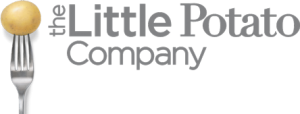Russet Potato vs Creamer Potato: The Nutritional Showdown

All potatoes are created equal, right? Not so! There are a variety of nutritional differences between a standard russet potato and a Creamer potato. When the two go head to head, who comes out the victor?
Why the Difference in Nutrition?
Nutrient content is based on a variety of factors related to growing conditions, such as mineral levels in the soil, geographical location, and sun exposure. Nutrient content can also vary based on the surface area (aka the skin of the potato), where a variety of nutrients can be found. The more surface area a potato has, the more potential for nutrients to favor inside.
Getting more potato skins (and nutrients) into your diet is as simple (and delicious) as eating more potatoes! Compared to eating one medium potato, like a russet, Little Potato Company Creamers give you lots of surface area to work with—and no peeling necessary!
Nutrition Comparison: Russet Potato and Creamer Potatoes
Let’s take a quick look at the side by side comparison for both types of potatoes. Can you spot a few of the key differences?

*Nutrition Data are shown for Blushing Belle
**Nutrition Data Accessed from: https://food-nutrition.canada.ca/cnf-fce/index-eng.jsp, Food Code #5285, August 2016
Little Potatoes contain more micronutrients (vitamins and minerals) per calorie and are therefore considered to be more nutrient dense. With 15 calories less per serving, Creamers contain more calcium, iron, and most notably, potassium.
[embedyt] http://www.youtube.com/watch?v=7hVE63AVgII[/embedyt]
Standout Nutrients
Potassium is important to the proper functioning of all cells. A healthy diet containing foods high in potassium and low in sodium may reduce the risk of high blood pressure, a risk factor for stroke and heart disease. Little Potato Company Creamers are a good source of potassium and are low in sodium.
Calcium and iron are found in higher amounts in Creamer potatoes. These nutrients can be harder to obtain from diet alone for vegetarians and vegans, and are required in higher amounts for athletes, and women in their childbearing years. Adding a variety of dietary sources throughout the day can help to boost our total daily intake.
A russet potato contains only slightly more fiber and protein, though what it mainly has in its favour is twice the Vitamin C content (let’s give it that!). By simply topping your Creamers with a squirt of lemon juice, garnishing with chopped parsley or bell peppers, or serving with a brightly colored vegetable (all sources of vitamin C), you’ll more than compensate for the difference.
Variety is the spice of life, so there’s no need to avoid russet potatoes altogether, just consider some of the nutrient features available to you through a simple dietary upgrade, like choosing Creamer potatoes. And if not for nutrition, we think the superior taste and quick cooking time of our Little Potatoes will keep you coming back for more.

Longevity Educator, Registered Holistic Nutritionist (RHN), Real Food Advocate and Endurance Athlete.
Emma Andrews is a Nutritionist (RHN) and Educator from Vancouver, Canada, and passionate about sport performance and longevity. Through her 10+ year career in the natural products industry, Emma has developed a deep understanding of ingredients, and nutritional…
Did you like what you read?
